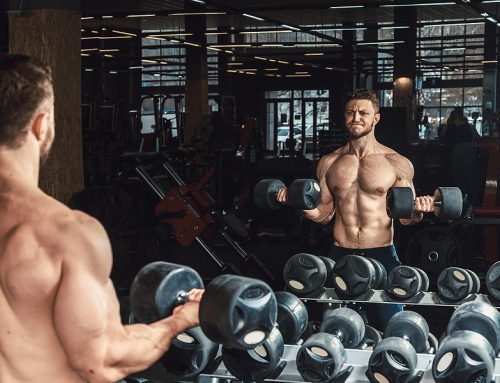There’s probably no topic that has been researched and debated more in the last ten years or so than resistance training volume. That is, how many sets per muscle group per week (and or per workout) are optimal for muscle gains?

Research has confirmed for certain that there is a dose-response relationship between volume and muscle growth. More sets produces more muscle gains.
We now know that the old “1 high intensity set to failure” approach is not optimal. (You can gain muscle with only 1 all-out set, but there’s no doubt that it’s not going to optimize muscle growth).
In addition, previous research has confirmed that counting hard sets is an excellent way to track your resistance training volume:
www.burnthefatinnercircle.com/members/Count-Sets-To-Predict-Muscle-Gain.cfm (Inner Circle members area)
Previous research has also suggested that 10 sets per major muscle per week is a good minimum to aim for if your goal is to optimize muscle growth. (A little less for smaller muscles).
www.burnthefatinnercircle.com/members/How-Many-Sets.cfm (Inner Circle members area).
However, adding more sets is only better up to a point. Greater gains are possible with more sets, possibly up to as many as 20 sets per muscle per week, but research so far suggests there is a diminishing rate of returns after 10 sets or so.
For example, you might capture 90% of your potential gains with 10 to 12 sets per muscle per week, and hit 100% at 15 to 20 sets, but you can see that those additional sets only give you an extra 10% or so, yet require much more time.
A professional bodybuilder might say it’s worth it to spend the extra time to try and optimize gains. But a recreational lifter training for general fitness and health might be perfectly happy to capture most of the gains with a more realistic time commitment.
With very high volumes, there is also an increased risk of overtraining, and at some point there is a U shaped curve that flattens out (gains slow down then stop). If you continue adding more and more sets, you may even reduce gains as you enter the overtraining zone.
It’s also worth noting that studies showing greater gains with 20 sets (or even, believe it or not, as many as 35 sets) per muscle per week, were based on that extreme high volume being done for only one body part. The rest of the body was trained with normal volumes.
20 sets or more per muscle group per week for every muscle in the body would crush almost anyone (overtraining), not to mention how impractical it would be with hours in the gym.
When doing high volume training, most people do it for only one body part or two as part of a specialization program.
Despite the large body of research we already have on this subject, and the solid guidelines we already have (ie, 10 to 20 sets per week is the currently widely accepted recommendation), there have been a lot of questions still remaining, such as:
* Is there a difference in response between men and women?
* Is there a difference in response with age?
* Exactly how much of an improvement is there by adding those additional sets beyond 10 per muscle per week? (and is it worth it?)
* Is there a “sweet spot” for weekly sets where we will optimize muscle gains with minimal risk of overtraining and while still keeping it practical?
* is there a difference between response in different muscle groups, ie, big muscles like the back vs small muscles like the calves?
A new study was recently published in the International Journal of Sports Medicine that helps answer some of these questions.
The subjects in this study were women. They were divided into groups that did 6, 9, or 12 sets per week respectively. In this study, they focused on measuring the gains in only one muscle group – the calf muscles.
Results: There was a major increase in muscle size when increasing from 6 sets to 9 sets. This provides confirmation of the current guideline to aim for approximately 10 sets per muscle per week and small muscles maybe slightly less.
There was an increase in muscle gains when increasing from 9 sets to 12 sets per week, but in this case, the increase was small. This provides confirmation of the idea that you can keep gaining even more muscle with more volume but there is a diminishing rate of returns beyond 10 sets per muscle per week.
From this study, what we don’t know is whether 15 sets or 18 sets would continue to produce even more muscle gains. It would make sense to predict that gains might continue to increase, but likely at a greatly diminished rate of returns.
Many other studies have shown continued increases in gains up to 20 sets and even beyond, but we have to ask ourselves whether it’s worth the time and effort if most of our gains come from 10 to 12 sets.
You also have to consider that it would be nearly impossible to recover from high volume training for every muscle in your body at the same time. Most of the research on the subject of high volume training involved working a single muscle, while the rest of the body was trained with lower, more normal volumes.
In addition, when trying high volume training, we know that it’s better to split those sets up across the week. The reason is because it would be impossible to put 100% effort and intensity (training close to failure) into 18 or 20 sets in a single workout. (20 sets to FAILURE for a big muscle in a single workout? I don’t think so).
So if someone wanted to push the envelope on volume to try and squeeze out every last ounce of gains, it would probably be smarter to do 9 or 10 sets twice a week than 18 or 20 sets once a week.
This study confirms that the standard guidelines seem to apply to both men and women. The results also appear to confirm that that current volume guidelines apply to small muscles like the calves as well as the larger muscles.
There still may be unanswered questions remaining and I have no doubt people will continue to debate or argue about this subject, but I think at this point we have some pretty solid guidelines for sets (volume).
Of course, it can depend on your goals, your recovery ability, and your personal circumstances, so if you have any questions about how many sets you should do in your situation, post in the comments below.
– Tom Venuto,
Author of Burn The Fat, Feed the Muscle.
Founder of Burn The Fat Inner Circle
PS. Don’t forget to check out the latest Burn the Fat Podcast: Episode 4 (click here)

Tom Venuto is a lifetime natural (steroid-free) bodybuilder, fitness writer and author of Burn The Fat, Feed The Muscle: Fat Burning Secrets of Bodybuilders and Fitness Models and the national bestseller, The Body Fat Solution, which was an Oprah Magazine and Men’s Fitness Magazine pick. Tom has appeared in The New York Times, Wall Street Journal, Huffington Post, Oprah Magazine, Muscle and Fitness Magazine, Ironman Magazine and Men’s Fitness Magazine, as well as on dozens of radio shows including Sirius Satellite Radio, ESPN-1250 and WCBS. Tom is also the founder and CEO of Burn The Fat Inner Circle – a fitness support community for inspiration and transformation
Scientific reference: Kassiano W et al, Bigger Calves from Doing Higher Resistance Training Volume?, International Journal of Sports Medicine, 10.1055/a-2316-7885, 2024






Two other important factors to consider are body type (ectomorph, mesomorph, endomorph). Ecto’s as a rule of thumb should do less sets, whereas meso’s and endo’s can benefit from more, especially mesos.
And the the number of years of training, and the level of muscular development achieved. Training volume needs to be reduced for advanced level bodybuilders and/or rest days between sessions increased. This is because of the overall level of stress on the nervous system and ability to recover. ie. A beginner with 12 inch arms taking them to failure puts nowhere near the stress on the body when those arms are developed up to 20 inches. The body’s ability to recover does not improve to the same degree as strength and muscular development increases. The body disproportionately increases in size and strength in regards to its recovery ability. Taxing the body too much leads to over training and loss of muscle.
Please define a “set”
Yeah good question in this context. A hard effort (intensity); within a rep or two of failure, and sometimes all the way to failure (esp on the last set of an exercise). I see people talking about leaving 3 or 4 reps in reserve but I dont think thats a very hard effort